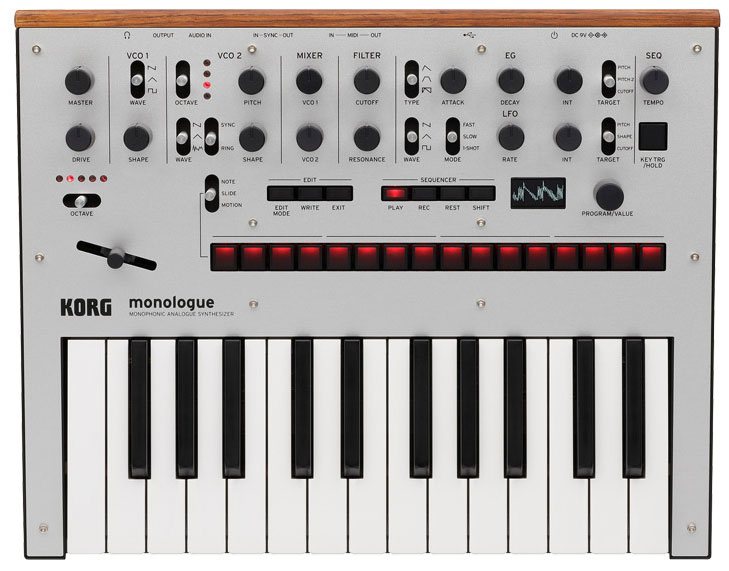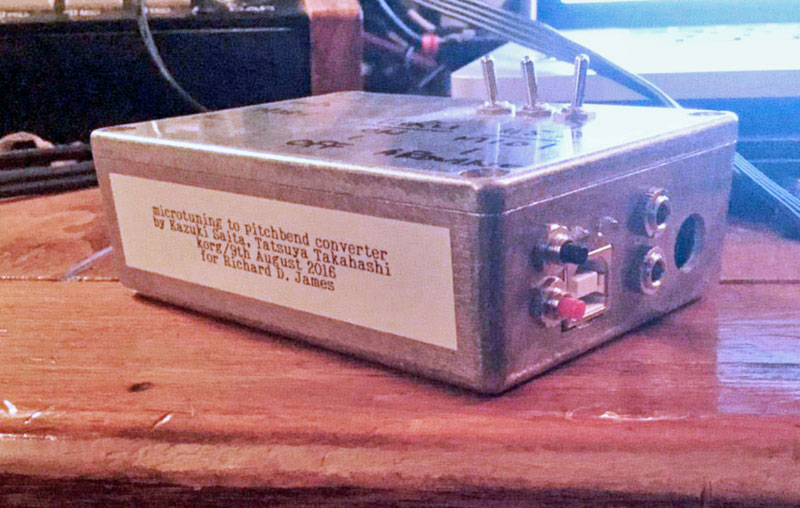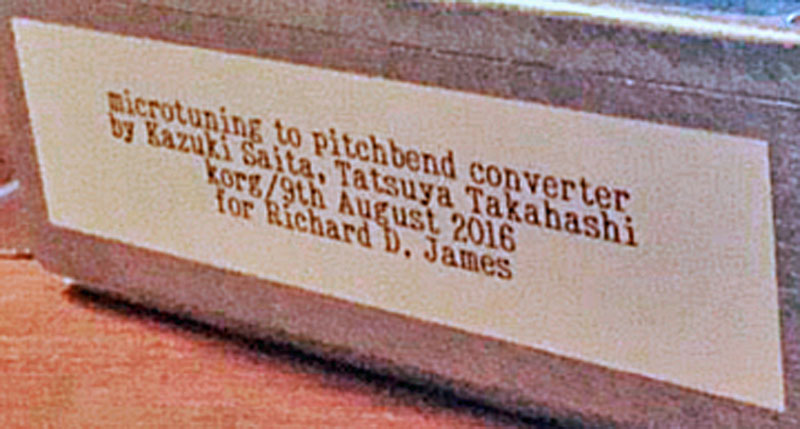



November 15, 2017
Last week a customer sent me an email containing a link to this article, an interview between Richard D. James (better known as Aphex Twin) and Tatsuya Takahashi, former synth engineer at Korg. I was told that this article contains a reference to a custom one-off tuning device similar to TBX1 or TBX2. Of course my interest was piqued, and I followed the link.
Click! My browser opened a beautifully designed webpage with lovely professional photographs, and I was struck by the word "microtuning" in the headline. This is sort of a rare thing, to find this word featured so prominently, much less in an article featuring an industry-leading synth engineer and a well known electronica personality. It felt pleasant to see this. I've always been a fan of Korg synthesizers. For about a decade, the Korg 01/W was a very important tool for my composing. Unfortunately, I'm not really familiar with the music of Richard D. James (Aphex Twin), though I have been aware of it peripherally since the late 90's. I've been told by a friend that it's good stuff.
There is a video at the top of the article which is intended to be an audio accompaniment, to listen to while you read. The video features a still image of the Korg Monologue analog monophonic synthesizer, and the audio is made with the same. I had recently looked into this synth, while researching products to mark as good test candidates for TBX2. The monologue caught my eye because of its low price point, its analog appeal, and its reputed microtuning functions.

A brief word before continuing this story. With increasing frequency I have been receiving questions about using my tuning software and devices with modular analog synthsizers. Each time I receive these queries, I feel a bit uneasy about responding, not only because MIDI and modular analog synths have always been fundamentally at odds with each other (the D in MIDI stands for Digital), but also because I don't work with analog equipment myself. For eurorack synth users, MIDI to CV (Control Voltage) converters are widely available. Using them is however an inherently problematic game, not to mention quite expensive (a MIDI-CV converter typically costs at least a couple of hundred Euros). But eurorack synth users are used to high costs, and I don't want to discourage anyone here. Connecting TBX2 to a MIDI-to-CV converter, and then connecting that converter to any analog rack synth should work as expected. How well it works depends on the synth. But analog users know that already too. Many smaller keyboard-based analog synths like the Monologue have MIDI DIN5 jacks and sometimes USB-MIDI, so the CV conversion is done internally. For working with MIDI that sounds promising, but it's hard to know how well it will work, because according to the documentation I read, these analog synths invariably use MIDI in idiosyncratic ways, and (not surprisingly) they don't tend to support MIDI standards the way digital synths do (again, D is for Digital). But I digress … [EDIT: a customer pointed me to this new device which is aimed at retuning modular synths. Despite being limited to two channels and a small number of tunings, it looks promising, and I'll be looking into ways TBX2 might be able to interface with it.]
Back to our story. Here we have an article about an analog synth, and microtuning, and somewhere in it is mention of a Tuning Box or something similar to mine, I'm told. Curious. So I play the video, and read.
Having skimmed through the Korg monologue documentation already before being led to this article, I was a little miffed at first as to all the fuss James and Takahashi initially make over its tuning functions. James says "It is now the only [hardware] synth on the market currently being made to have full microtuning editing" Hm, could that really be true? There are certainly other synths supporting 12-notes-per-octave microtunings with editing features built in, across a wide range of prices, from bargain Casio to high end Roland. And in the Monologue manual I had found instructions for manually inputting microtunings, but nothing about supporting the MIDI Tuning Standard, or GM microtuning (what the MIDI association is calling MPE), or any proprietary protocol. I found a video on YouTube which includes a demonstration of the microtuning functions of the Monologue. I've cued it below to the appropriate spot. [EDIT1: Hm, it looks like embedding a video at a cue time doesn't work, so you'll have to click in the video timeline at about 3:50 to see the tuning demonstration.] [EDIT2: on the Korg website they say that the Monologue supports MTS "3-Byte messages", but they provide no documentation.]
The demonstration is not very impressive, though it gives at least an idea of what's available. It is uncommon for an analog synth to provide microtonal functions, and perhaps the full-range tuning (any key to any pitch) really is unique among hardware synths in current production. I seem to remember Kurzweil keyboards like the K2000 having similar functions. Not analog, of course. [EDIT: a customer pointed out that several Dave Smith Instruments analog synths support the MIDI Tuning Standard, which is correct, though they do not have on-board full range tuning editing as far as I can tell, so what James is saying might be true and just rather a chore to parse.] In any case, I was still looking for mention of this other curious little Tuning Box, so I kept reading.
And eventually I found it. (Which you can too, if you scroll down to about the middle of the page.) There is even a picture of it.

Tatsuya Takahashi says, "Richard asked me for microtuning on our synths and since, at the time, we thought it wasn't something we would put on a production model, we made a custom little tuning tool. Fellow engineer Kazuki Saita and I made a MIDI thru box that could load custom scales. Any MIDI coming in would be transposed by note and cent (using pitch bend) and so you could get microtuning on any mono synth."
Hm, so Korg made a little monophonic tuning box. Interesting.
At this point I paused and thought back on an email I had received some time in 2015, from someone informing me that Aphex Twin had mentioned my software CSE (Custom Scale Editor) in an interview somewhere. I never found this interview. Was it online? Radio? I don't know, and now I can't even find that email. Hm. It's as if it just disappeared. Maybe it never happened? Or someone wants me to doubt it. In fact, that all seems to fit perfectly with the air of mystery and confusion that Aphex Twin (Richard D. James) typically likes to maintain, or so I've heard. CSE is very closely linked with the Tuning Box (TBX1). It is the editor with which one makes tunings to upload to the box, to retune synths. Was something strange going on here? [NOTE: Thanks to the keen eye of one of our readers, the disappeared Richard James interview mentioning H-Pi Instruments software was unearthed using the indefatigable WayBack Machine here]
The label on the custom Korg device in the picture is oddly specific, stating that it was made on the 9th of August, 2016, which happens to be the day after I got married.

If this were a bad made-for-TV movie, the underscoring and camera angles might suggest to the viewer that someone knew that a picture of this would show up online, and wanted to make sure it would be clear that this one-off device was created a point in time in the a context of a certain flow of information … after the supposed public mention of my tuning software by Aphex Twin, who knew about TBX1, the H-Pi Instruments Tuning Box, at least as early as 2015. Why then would he hire engineers at Korg to make a special box for him, when he knew that such a box already exists? Of course, this is all silly, and wrong. The box they made, as described by Takahashi, is only for monophonic synths — quite limited and rudimentary in comparison to TBX1. Clearly they didn't know about TBX1. Clearly. Or did they? No, of course they didn't.
The rest of the article is not very relevant to microtuning.
Why write about this interview which extolls the virtues of the Korg Monologue synth for its tuning features and includes mention of a little primitive Tuning Box from Korg? Well, obviously because I've developed a product that can do all these wonderful things, not just monophonically, and not just with one specific synthesizer, and not even in a proprietary way. If Takahashi and James are thrilled about the Monologue, they'll also be thrilled about TBX2. It does those cool things the Monologue does with tuning, and a lot more, on a huge range of available synthesizers. The monologue stores 6 user defined tunings, which apparently have to be edited manually at the unit itself. That's nice and maybe convenient for working a certain way, but it's rather confining. And what about interoperability? It's important that musical instruments can work together, that they can share common tuning systems. This is a point discussed in the article in the context of A440. The tunings should be portable, editable, exchangeable, interchangeable. That suggests developing software and working with known tuning standards, as I've done with CSE. What about variety of expression and the freedom to use not just a handful of tunings, but a wide range of them? 6 is definitely not enough. 512 seems like a better number (TBX1). 8192 seems like a much better number (TBX2).

Microtuning is a vast landscape with enormously powerful expressive variety and potential for creating music that really and truly sounds new and different. The new TBX2 makes that possible on the widest range of available MIDI instruments. At the time of writing this, there are 53 units still available. There is still time to reserve yours before the earlybird reserve ends November 30.
Best Regards,
Aaron
[ Showing 1 entry | Previous entry | Next entry | Show all entries ]